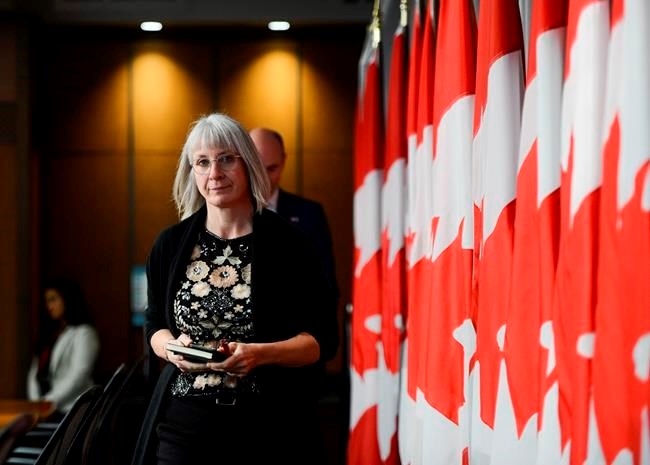OTTAWA — As Canadians see COVID-19 restrictions lifting, federal Health Minister Patty Hajdu says she believes the country is better prepared for a second wave of the novel coronavirus thanks to some difficult lessons learned over the last four months.
That includes efforts to improve the "fractured" way in which health data is collected by the provinces and territories, and how difficult it can be to have it reported to the federal level, Hajdu told a Senate committee Friday.
More detailed data is needed to track how vulnerable certain populations are to the novel coronavirus and where to focus efforts on testing, tracing and other supports, she said.
"That has been a weakness for us all along is our ability to actually understand what's happening nationally," Hajdu said.
That's why federal officials are working on national standards for health data collection — and ensuring information is shared quickly with Ottawa — as part of ongoing negotiations with the provinces over $14 billion in new federal COVID-19 transfers.
When the COVID-19 outbreak first began, federal public health officials encountered roadblocks getting even basic epidemiological data from other jurisdictions to get a national picture of transmission rates, chief public health officer Dr. Theresa Tam told the committee.
She said this basic data is now coming more quickly, but officials are working on getting more detailed information about specific populations.
Raced-based data, including whether those being tested for COVID-19 have self-identified as First Nations, Inuit or Metis, has not been available at the federal level in part because not all jurisdictions have been collecting that information.
This is an area public health officials are now "working very hard on," Tam said.
"You may have seen some jurisdictions at the local level, such as Toronto, that are now collecting this data, which we hope to obtain," she said.
"We are also engaging various partners to undertake specialized surveys and enhanced surveillance activities among key populations of interest, some of which are the racialized communities."
The Public Health Agency of Canada has also partnered with Statistics Canada on a "ethno-cultural data dashboard" that Tam says will be released soon.
But some of the information still needed to better understand the impact of the virus on different communities cannot be obtained through surveys and surveillance, Tam added, which is why the agency is also working with the Canadian Institutes of Health Research to co-ordinate academic research activities to further address the current data gaps.
Hajdu and Tam also reflected on the major learning curve for federal officials in trying to procure personal protective equipment at a time of a global surge in demand.
The national strategic stockpile of medical supplies was never meant to house mountains of personal protective equipment, Hajdu said, and provinces are responsible for maintaining their own stockpiles.
When it became clear a bulk procurement order would be needed to address shortages across the country, federal officials ran into roadblocks trying to get the information they needed from provinces and territories about exactly how much they might need.
"It took several government departments working with numerous provincial representatives to try and figure out the actual requirements, the rate of use and now, planning forward in a world that is still somewhat precarious in terms of ingredients and supply," Tam said.
Finally, the federal government simply went ahead with a procurement order "making some best estimates and assumptions about what we would likely need as a nation," Hajdu said.
"Don't forget that the crisis started in China and, incidentally, that is where a lot of the equipment is created, so of course this double whammy of having a crisis in a country where, in many ways, it is the largest provider of PPE for the world, created a really tight supply chain that trickled and rippled through the world," Hajdu added.
Canada has since been ramping up its domestic manufacturing of personal protective equipment, testing agents and medical supplies to limit the country's vulnerability to disrupted global supply chains in the case of future outbreaks.
"We are dramatically readier than we were during the outbreak because we have developed much stronger relationships with provinces, territories and local governments to make sure that we can act quickly when there is an outbreak," Hajdu said.
Chief medical health offices across the country are now actively preparing for the possibility of a resurgence of the virus in the fall or winter, or perhaps even sooner.
This work also includes preparations to deal with the potential for simultaneous outbreaks of both COVID-19 and influenza, Tam said.
"We're singularly focused right now in trying to do everything we can to prepare for any resurgence."
This report by The Canadian Press was first published June 26, 2020.
Teresa Wright, The Canadian Press



